Kaunos
Q608095Kaunos (Carian Kbid, Greek Καῦνος, Latin Caunus): port in Caria at the mouth of the river Kalbis, modern Dalyan.
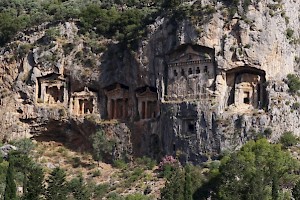
Kaunos was a port in Caria at the mouth of the river Kalbis, on the border of Lycia. Today, the ancient harbor is an inland lake, some five kilometers from the sea.
Origin
According to tradition, the eponymous founder of Kaunos was the son of Miletus of Crete, who was a son of Apollo. Kaunos' mother Cyana was a daughter of the river Meander. Kaunos fled his home because he was hopelessly in love with his twin sister Byblis, and founded the city of Kaunos. The story may have been invented to explain why the Kaunians, although they spoke Carian, had different customs.note
History
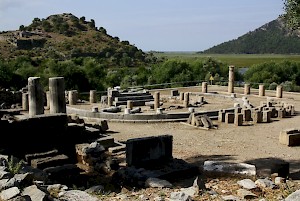
In the 540s BCE, General Harpagus, fighting for Cyrus the Great, conquered the region, despite bitter resistance from Kaunos.note After the Greek victory over Persia in the naval battle of Salamis in 480 BCE, Kaunos joined the Delian League and was part of the Athenian zone of influence. In the fourth century BCE Persian rule was reestablished under the satraps Hecatomnus and then his son Maussolus. To the north of the acropolis, the remnants of the Persian defensive walls, eight meters high, are still visible.
After Alexander the Great's general Ptolemy had conquered the area in 333 BCE,note the city had several masters: Antigonus, Ptolemy, Demetrius, Lysimachus, the Ptolemies (since 309), the Seleucids, the Rhodians, and finally (after 166) Rome. In 88 BCE Kaunos supported Mithridates VI of Pontus against Rome and massacred resident Roman citizens. The Romans defeated Mithridates and punished Kaunos by returning the city in 81 to the Rhodians. which continued well into the first century.
The Graeco-Roman city
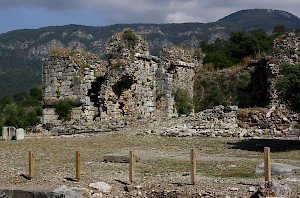
Strabo of Amasia describes Kaunos at the beginning of our era and mentions that people in this coastal area often suffered from malaria:
The city has dockyards, and a harbor that can be closed. Above the city, on a height, lies Imbros, a stronghold. Although the country is fertile, the city is agreed by all to have foul air in the summer, as also in autumn, because of the heat and the abundance of fruits. And indeed little tales of the following kind are repeated over and over, that Stratonicus the citharist, seeing that the Kaunians were pitiably pale, said that this was the thought of the poet in the verse, "even as is the generation of leaves, such is that also of men"; and when people complained that he was jeering at the city as though it were sickly, he replied, "Would I be so bold as to call this city sickly, where even the corpses walk about?"note
"Imbros" was the name of the 150 m. high acropolis, which was once surrounded on three sides by the sea. Down the hill was a temple, dating back to the first century BCE, which was dedicated to the supreme god Zeus, who was called Basileus Kaunios, "lord of Kaunos". It contained a sacred stone that had been in religious use since the fifth century BCE.
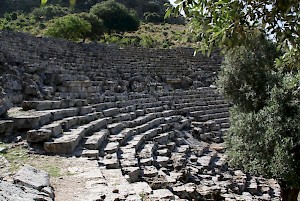
The theater, to the west of the acropolis, had thirty-three rows and could accommodate some five thousand people. Dating back to the second century BCE, it was as old as the terrace temple of Apollo, which was at walking distance. Further down was a stoa from the third century BCE, almost a hundred meters long, following the northern edge of the agora. It had a row of columns in front and a wall in back. Archaeological finds indicate that this was the site where sailors venerated Aphrodite. On the southern wall is a nymphaeum, which was dedicated in the late first century to Emperor Vespasian.
Late Antiquity
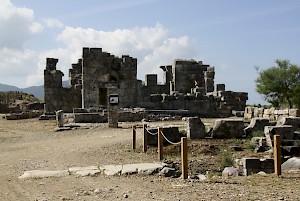
Kaunos became a Christian town in the fourth century. The remains of a sixth-century, domed church with three naves, measuring some 14 x 14,5 meters, are still visible.
Visit
Kaunos can easily be reached by boat from the nearby village of Dalyan. During the boat trip, which lasts about a quarter of an hour, one can see the beautiful and well-preserved Lycian rock-cut tombs on the hill near the site.